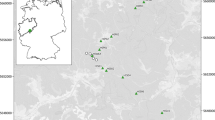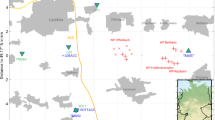Abstract
Due to the increased expansion of wind turbines (WTs) in the last two decades, seismologists have recently observed an impact of disturbing signals at seismic stations. Ground vibrations generated by WTs perturb the seismic background noise level at seismological monitoring sites causing the performance and functional capability of a seismological network to be limited which leads a conflict between operators of WTs and seismological institutions. With regard to a conflict settlement, the research project MISS (Minderung der Störwirkung von Windenergieanlagen auf seismologische Stationen) was initiated to investigate in detail the seismic signals emitted by a WT in order to identify and discuss methods to reduce the disturbance impact on seismic stations. A part of this research project is presented in this study and deals with movement patterns of a WT tower, foundation and the immediate subsurface as well as the amplitude decay behavior of the seismic noise with increasing distances to the WT. For this purpose, short- and long-term measurements were conducted at a single WT of the “Bürgerwindpark A31 Hohe Mark” located in Heiden (NRW, Germany). First, the first four eigenfrequencies of the WT tower are identified at 0.3 Hz, 1.1 Hz, 3.25 Hz and 6.0 Hz using 1.5-h recordings of sensors that were installed in different heights on the inner wall of the tower. From the measurements, linear, elliptical and circular motion patterns could be observed at the tower. The results of the long-term measurements using 15 mobile seismic stations installed over 1 month in two circular arrays with distances of 100 and 200 m around the WT and two additional stations, one deployed on the foundation and one directly besides in the field, also show linear, elliptical and circular particle movements of the foundation and shallow underground. By correlating power spectral density (PSD) spectra and vertical displacements with the prevailing wind direction, it can be shown that at the eigenfrequencies 0.3, 3.25 and 6.0 Hz Rayleigh waves are radiated in crosswind direction from the WT. In downwind direction, the wave field is dominated by the Love wave type. In contrast, at 1.1 Hz, the dominating wave type emitted by the WT in crosswind direction is Love wave and in downwind direction mainly of the Rayleigh wave type. In order to estimate an amplitude decay relationship of the WT-induced seismic waves, a 1.5-h line-array measurement with 36 sensors installed 100–1000 m from the WT and a sensor spacing of 25 m was used to determine attenuation curves of ground motion velocities proportional to r−b, with r as the distance between sensor and WT and b as the decay parameter, for the four eigenfrequencies of the tower. The calculated b-values are increasing with frequency from 0.30 to 0.86.










Similar content being viewed by others
References
Flores Estrella H, Korn M, Alberts K (2017) Analysis of the influence of wind turbine noise on seismic recordings at two wind parks in Germany. J Geosci Environ Prot 5(05):76
Friedrich A, Krueger F, Klinge K (1998) Ocean-generated microseismic noise located with the Grafenberg̈ array. J Seismol 2(1):47–64
Friedrich T, Zieger T, Forbriger T, Ritter JR (2018) Locating wind farms by seismic interferometry and migration. J Seismol 22(6):1469–1483
Gassenmeier M, Sens-Schönfelder C, Delatre M, Korn M (2014) Monitoring of environmental influences on seismic velocity at the geological storage site for CO2 in Ketzin (Germany) with ambient seismic noise. Geophys J Int 200(1):524–533
Groos J, Ritter J (2009) Time domain classification and quantification of seismic noise in an urban environment. Geophys J Int 179(2):1213–1231
Hu W, Barthelmie RJ, Letson F, Pryor SC (2019) Seismic noise induced by wind turbine operation and wind gusts. Seismol. Res. Lett.
Lerbs N, Zieger T, Ritter J, Korn M (2020) Wind turbine induced seismic signals: the large-scale SMARTIE1 experiment and a concept to define protection radii for recording stations. Near Surface Geophysics 18(5):467–482
Lowrie W (2007) Fundamentals of geophysics. Cambridge University Press, Cambridge
Marcillo OE, Carmichael J (2018) The detection of wind-turbine noise in seismic records. Seismol Res Lett 89(5):1826–1837
Marinone T, Cloutier D, LeBlanc B, Carne T, Andersen P (2014) Artificial and natural excitation testing of SWiFT Vestas V27 wind turbines. Dynamics of Coupled Structures 1:343–353. Springer
Nagel S, Zieger T, Luhmann B, Knödel P, Ritter JRR, Ummenhofer T (2019) Erschütterungsemissionen von Windenergieanlagen. Stahlbau 88(6):559–573
Neuffer T, Kremers S (2017) How wind turbines affect the performance of seismic monitoring stations and networks. Geophys J Int 211(3):1319–1327
Neuffer T, Kremers S, Fritschen R (2019) Characterization of seismic signals induced by the operation of wind turbines in North Rhine-Westphalia (NRW), Germany. J Seismol 23 (1):1161–1177
Saccorotti G, Piccinini D, Cauchie L, Fiori I (2011) Seismic noise by wind farms: a case study from the Virgo Gravitational Wave Observatory, Italy. Bull Seismol Soc Am 101(2):568–578
Sato H, Fehler MC, Maeda T (2012) Seismic wave propagation and scattering in the heterogeneous Earth, 2nd edn. Springer, Berlin
Schofield R (2001) Seismic measurements at the stateline wind project. Rept No LIGO T020104-00-/, Laser Interferometer Gravitational Wave Observatory available at http://www.ligocaltechedu/docs
Stammler K, Ceranna L (2016) Influence of wind turbines on seismic records of the Gräfenberg array. Seismol Res Lett 87(5):1075–1081
Styles P, Stimpson I, Toon S, England R, Wright M (2005) Microseismic and infrasound monitoring of low frequency noise and vibrations from windfarms. Recommendations on the siting of windfarms in the vicinity of Eskdalemuir, Scotland, Report to MOD/FTI/BWEA, pp 125
Westwood RF, Styles P (2017) Assessing the seismic wavefield of a wind turbine using polarization analysis. Wind Energy 20(11):1841–1850
Xi Engineering Consultants Ltd (2014) Seismic vibration produced by wind turbines in the Eskdalemuir region. Release 2.0 of Substantial Research Project, Xi Engineering Consultants Conference House, 152 Morrison Street, Edinburgh, EH3 8EB, xiengineering.com
Zieger T, Ritter JR (2017) Influence of wind turbines on seismic stations in the upper rhine graben, SW Germany. J Seismol 22(1):105–122
Zieger T (2019) Experimental quantification of seismic signals induced by wind turbines. PhD Thesis
Acknowledgements
The authors are grateful to the operators of the “Bürgerwindpark A31 Hohe Mark” in Heiden (North Rhine-Westphalia, Germany) for the cooperation, permission to conduct the measurements and providing operational data of the WT. We also thank “Enercon GmbH” for the safety training to install the sensors on the tower of the WT and the owners of the sites on which the mobile seismic stations were installed during the measurement campaigns. We also thank the two anonymous reviewers for their recommendations that greatly improved this work.
Funding
The MISS research project is funded by the “Europäischer Fonds für regionale Entwicklung (EFRE)”.
Author information
Authors and Affiliations
Corresponding author
Additional information
Publisher’s note
Springer Nature remains neutral with regard to jurisdictional claims in published maps and institutional affiliations.
Rights and permissions
About this article
Cite this article
Neuffer, T., Kremers, S., Meckbach, P. et al. Characterization of the seismic wave field radiated by a wind turbine. J Seismol 25, 825–844 (2021). https://doi.org/10.1007/s10950-021-10003-6
Received:
Accepted:
Published:
Issue Date:
DOI: https://doi.org/10.1007/s10950-021-10003-6




